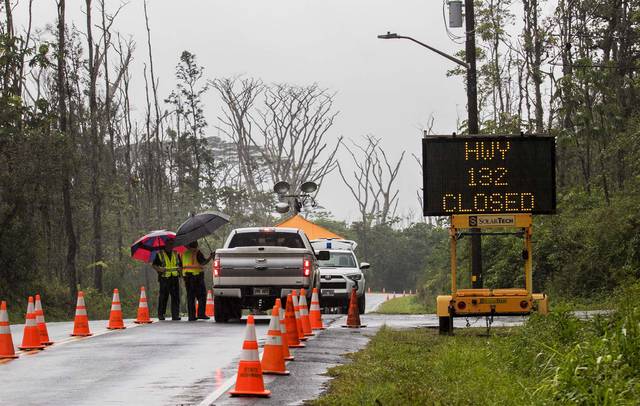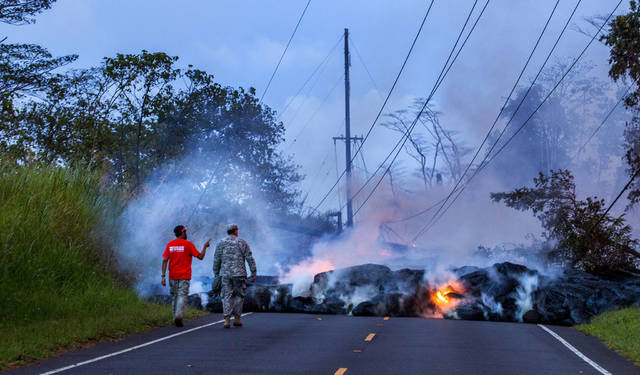Fast-moving lava shuts down highway near Leilani Estates






DENNIS ODA / DODA@STARADVERTISER.COM
Highway 132 near Pohoiki Road past Pahoa was closed this morning due to lava.

U.S. GEOLOGICAL SURVEY
Tephra was seen at the intersection of Leilani and Kupono streets this morning, looking toward the east. Tephra is the general name given to anything thrown into the air during a volcanic eruption. It can range from individual ash particles all the way to volcanic bombs.

DENNIS ODA / DODA@STARADVERTISER.COM
Lava from fissure 8 flowed over Pohoiki Road, Monday, between Leilani Estates and the Puna geothermal plant. A USGS scientist and national guardsman walked toward the flow to check the air quality.

COURTESY HAWAIIAN VOLCANO OBSERVATORY
The view this morning from a research camera facing south-southeast towards the active vent in Halemaumau Crater from the observation tower at the Hawaiian Volcano Observatory.

DENNIS ODA / DODA@STARADVERTISER.COM
The National Guard took the media out on a tour of the lava sites in Leilani Estates. Jeff Hickman, public affairs officer for Hawaii National Guard, stood in front of fissure 7, Sunday, on Leilani Ave. talking about the dangers of getting too close to the lava flow. He said this is as close to the eruption that we could go to be safe. Air quality conditions indicated it was completely safe.

COURTESY U.S. GEOLOGICAL SURVEY
Map of the Kilauea Lower East Rift Zone fissures and flows as of Monday afternoon.











UPDATE: 8:45 a.m.
Access is blocked to Issac Hale Beach Park for recreational purposes, according to Hawaii County Civil Defense.
Hawaiian Volcano Observatory officials said the reactivated fissure 8 was fountaining up to 200 feet overnight, also feeding a lava flow traveling to the northeast. Fissures 18, 19 and 20 show continued weak activity.
6:40 a.m.
Authorities shut down Highway 132 between Lava Tree State Park to 4 Corners due to fast-moving lava approaching the highway, according to Hawaii County Civil Defense. Everyone is advised to avoid the area.
Beach Road is the only access into lower Puna.
Don't miss out on what's happening!
Stay in touch with breaking news, as it happens, conveniently in your email inbox. It's FREE!
6:30 a.m.
A lava flow from fissure 8 began moving rapidly to the northeast near Kahukai Road before 4 a.m., crossed Pohoiki Road at 5 a.m. and is moving along the northern margin of an older flow toward the Puna Geothermal Venture access road, according to Hawaii Volcano Observatory officials.
Tuesday 4:45 a.m.
A simultaneous ash eruption and light earthquake struck the Kilauea summit area early this morning.
The eruption occurred at about 2 a.m. and shot an ash plume 15,000 feet high, according to Hawaii County Civil Defense. With the prevailing winds blowing from the northwest, the towns of Volcano, Pahala and Naalehu are likely to see the most ash fallout.
The magnitude 4.5 quake struck at 1:56 a.m. at depth of around half a mile and was centered 3.7 miles west-southwest of Volcano, according to the U.S. Geological Survey.
No serious injuries were immediately reported and no tsunami was generated.
Monday 6:19 p.m.
Hawaiian Volcano Observatory geologists report a fast-moving pahoehoe lava flow from fissure No. 8, moving toward on Nohea and Kupono streets, north of Leilani Avenue.
Lava fountains have been reported on Moku Street, say Hawaii County Civil Defense officials, who warn anyone in the area from Pomaikai Street east to leave the area immediately.
Civil Defense reminds the public that:
>> Residents close to the eruption need to leave the area to avoid being isolated by the flow.
>> Authorities are going door to door on the affected streets.
>> And shelters at the Pahoa and Keaau community centers, and at the Sure Foundation Church are open and pet-friendly.
5:49 p.m.
An earthquake with a preliminary magnitude of 4.4 struck the Hilina region of Kilauea volcano, but was not strong enough to generate a tsunami, officials said.
Officials with the Pacific Tsunami Warning Center on Oahu said that while no tsunami is expected, “some areas may have experienced shaking.”
The quake shook the area at about 5:40 p.m.
The U.S. Geological Survey estimated the magnitude at 4.1 and said it was centered about 6 miles south of Volcano village at a depth of roughly 3.4 miles.
>> Hawaiian Volcano Observatory finds temporary home at UH-Hilo
>> Overlook Crater vent broadens as rocks become ammo for future blasts
>> Lava speeds up and bears down on Puna geothermal wells
>> Kilauea eruption: Is recovery possible?
>> 2014 lava survey hints at looming basic needs
>> Puna resident recounts arrest for trying to get to his home in evacuation zone
>> Puna family still in shock; others hold on, hoping they’ll be spared
>> Puna man ‘just wanted to live’ after nearly losing leg to lava bomb
RELATED PHOTOS AND VIDEO
>> Live webcams from Hawaii island
>> No break over holiday weekend for Kilauea, May 28
>> Lava in Leilani Estates and a look at the rescue helicopters, May 26
>> Victor Hoapili talks as lava fountains erupt in his backyard
>> Ken Szymanski talks about lava fissures in his neighborhood
COMPLETE KILAUEA COVERAGE
>> Star-Advertiser volcano coverage
>> Kilauea Volcano YouTube playlist
5:40 p.m.
Lava continued to flow in Leilani Estates and Lanipuna Gardens today in the fourth week of Kilauea volcano’s “vigorous eruption,” scientists said.
Hawaiian Volcano Observatory geologists said that the lava flow from fissure No. 8 reached Pohoiki Road this morning but stalled.
During a 1 p.m. overflight, fissures 8, 18, 20, 22, 6/13, and 7/21 had reactivated with fissure No. 7/21 having the highest fountains, they said.
“The reactivated fissures have not yet erupted enough lava to reach the coast so the two ocean entry sites were relatively inactive. Only a minor ooze of residual lava was entering the ocean from the eastern channel,” according to HVO’s latest update.
They added that if a shift in wind direction occurs today, as predicted, widespread vog could occur on the Big Island.
At Kilauea’s summit, ash continued to erupt intermittently from Halemaumau crater. Weaker winds threaten to send volcanic ash to communities near the summit.
The latest lava and eruption activity on Kilauea’s Lower East Rift Zone and summit began May 3 with a lava outbreak in Leilani Estates, followed by a magnitude 6.9 earthquake the next day and increased steam-driven ash and rock explosions from Halemaumau Crater.
1 p.m.
The National Weather Service said light easterly winds are expected to push volcanic gases westward. This includes increased ash and sulfur dioxide downwind of the Kilauea summit and fissures on the East Rift Zone.
Hawaii Electric said power interruptions are likely in the lower East Rift Zone. Power will be rerouted to Leilani Estates and lower Puna areas starting at 3 p.m.
Two community meetings will be held this week. Tuesday’s meeting is scheduled for 5 p.m. at Pahoa High School’s cafeteria. Wednesday’s meeting is scheduled for 5:30 p.m. in the multi-purpose room at Kau High.
12 p.m.
Lava flowing out of Leilani Estates started crossing Pohoiki Road today at around 8 a.m.
However, its advance has slowed from hundreds of yards per hour on Sunday night to a few yards per hour this morning, according to the Hawaiian Volcano Observatory.
Fissure 9 is reactivated but erupting only small quantities of lava that are pooling nearby.
PREVIOUS COVERAGE
Lava flows that overran part of the Puna geothermal power plant ceased overnight after covering two wells earlier in the evening, Hawaii County reported this morning.
County officials said there was no release of any dangerous hydrogen sulfide gas, as some feared might happen if lava breached the well shafts that tap steam and hot water several thousand feet down to make electricity through turbines.
There also were no reported injuries from the flow that pushed molten rock into the Puna Geothermal Venture plant and also triggered an emergency evacuation alert for parts of the neighboring Leilani Estates subdivision.
The alert was issued at about 7:30 p.m. over mobile phones in an area covering large parts of three roads in the rural subdivision.
Public safety officers with the Hawaii County Fire Department, the state Department of Land and Natural Resources, the Hawaii County Department of Public Works and the National Guard also moved house to house in the subdivision where relatively few people remain.
The county said the alert was issued because lava was moving at a “fast walking pace.”
On-the-ground evacuation personnel were also aided by U.S. Geological Survey drones equipped with infrared sensing equipment that helped locate people.
At least 10 homes were destroyed overnight by the relatively brisk flow, the county reported.
This lava was largely from fissure 7, which was the most active vent out of five producing lava on Sunday in or near Leilani Estates.
However, as of this morning fissure 7 was not producing lava, the county said.
Only two fissures were producing lava this morning — 8 and 24. Fissure 24 opened up Sunday, almost four weeks since lava began flowing May 3.
Puna Geothermal Venture shut down its power plant featuring 10 wells shortly after the lava eruptions, and has taken measures to seal off the wells with the potential to re-tap them at some point.
At the Kilauea summit miles away from Pahoa and Leilani Estates, there continue to be frequent explosions of ash from the caldera crater. Ash this morning reached nearly 15,000 feet.
Halema'uma'u is BLOWING UP this morning! 6:30 am BIG explosion with ash cloud billowing to nearly 15000 feet MSL! This is after the 4:30 am explosion (12000') Images courtesy NPS and USGS. #hivolcano pic.twitter.com/1JquiNFMAm
— Robert Ballard (@firebomb56) May 28, 2018
Because of light winds around 5 miles per hour, sulfur dioxide, which is irritating and less of a health concern than hydrogen sulfide gas, is pooling and drifting towards areas around Ocean View and Pahala.
The sulfur dioxide produced by the lava eruptions could also drift to areas including Pahoa, Nanawale, South Hilo and towards Hamakua, the county reported.
Tradewinds that typically blow the sulfur dioxide away from most East Hawaii populations are expected to return Wednesday.




